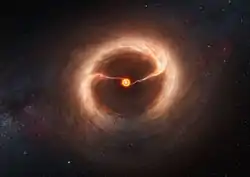HD 142527
HD 142527 is a star in the constellation of Lupus.[4][5] It is notable for its protoplanetary disk and its discovery has helped refine models of planet formation.
 Artist’s impression of the disc and gas streams around HD 142527 | |
| Observation data Epoch J2000 Equinox J2000 | |
|---|---|
| Constellation | Lupus |
| Right ascension | 15h 56m 41.88986s[1] |
| Declination | −42° 19′ 23.2746″[1] |
| Apparent magnitude (V) | 8.34[2] |
| Characteristics | |
| Spectral type | F6 III[2] |
| Astrometry | |
| Radial velocity (Rv) | -3.10[2] km/s |
| Proper motion (μ) | RA: -11.19[1] mas/yr Dec.: -24.46[1] mas/yr |
| Parallax (π) | 4.29 ± 0.98[1] mas |
| Distance | approx. 800 ly (approx. 230 pc) |
| Details | |
| Mass | 2.5 M☉ |
| Surface gravity (log g) | 3.15[3] cgs |
| Temperature | 6632[3] K |
| Metallicity [Fe/H] | 0.33[3] dex |
| Age | 1 Myr |
| Other designations | |
| Database references | |
| SIMBAD | data |
Protoplanetary disk
HD 142527 is an extremely young star, aged about 1 million years old[6] so it retains its protoplanetary disk which has a mass of 15% of the mass of the Sun and a diameter of 980 AU.
The studies have shown eddies and vortex structures forming in the nebulae under the influence of two large planets.[7] The star is important as it allows Astronomers to observe the accretion process in planetary formation.
In early 2013 an article was published by astronomers, working with the ALMA telescope in Chile, which refers to the discovery of two massive flows of matter in the system.[8] Substance consisting of dust and gas, is transferred from the periphery to the center due to gravitational interaction with two giant planets that have a mass several times greater than the mass of Jupiter. Thus, the flows are a kind of "pumps" pumping material from the edge of the center, "feeding" star. The planets themselves have not been detected so far, due to a dense shroud of gas. However, astronomers proposed models that describe their existence.
Also Japanese astronomers have discovered particles of ice[9] in the disk.
References
- van Leeuwen, F. (2007). "Validation of the new Hipparcos reduction". Astronomy and Astrophysics. 474 (2): 653–664. arXiv:0708.1752. Bibcode:2007A&A...474..653V. doi:10.1051/0004-6361:20078357. Vizier catalog entry
- "HD 142527". SIMBAD. Centre de données astronomiques de Strasbourg. Retrieved 5 January 2017.
- Luck, R. Earle (2015). "Abundances in the Local Region. I. G and K Giants". The Astronomical Journal. 150 (3). arXiv:1507.01466. Bibcode:2015AJ....150...88L. doi:10.1088/0004-6256/150/3/88.
- http://simbad.u-strasbg.fr/simbad/sim-id?Ident=HD+142527
- Simon Casassus, Gerrit van der Plas, Sebastian Perez M, William R. F. Dent, Ed Fomalont, Janis Hagelberg, Antonio Hales, Andrés Jordán, Dimitri Mawet, Francois Ménard, Al Wootten, David Wilner, A. Meredith Hughes, Matthias R. Schreiber, Julien H. Girard, Barbara Ercolano, Hector Canovas, Pablo E. Román & Vachail Salinas,Flows of gas through a protoplanetary gap, Nature 493, 191–194 (10 January 2013) .
- Hideaki Fujiwara, Mitsuhiko Honda, Hirokazu Kataza, Takuya Yamashita, Takashi Onaka, Misato Fukagawa, Yoshiko K. Okamoto, Takashi Miyata, Shigeyuki Sako, Takuya Fujiyoshi, Itsuki Sakon. The Asymmetric Thermal Emission of Protoplanetary Disk Surrounding HD 142527 Seen by Subaru/COMICS
- Simon Casassus et al. Flows of gas through a protoplanetary gap. Nature (02 January 2013).
- Simon Casassus et al. ,Flows of gas through a protoplanetary gap, Nature 493, 191–194 (10 January 2013).
- Honda, M.; Inoue, A. K.; Fukagawa, M.; Oka, A.; Nakamoto, T.; Ishii, M.; Terada, H.; Takato, N.; Kawakita, H.; Okamoto, Y. K.; Shibai, H.; Tamura, M.; Kudo, T.; Itoh, Y. Detection of Water Ice Grains on the Surface of the Circumstellar Disk Around HD 142527. The Astrophysical Journal Letters, Volume 690, Issue 2, pp. L110-L113 (2009).
